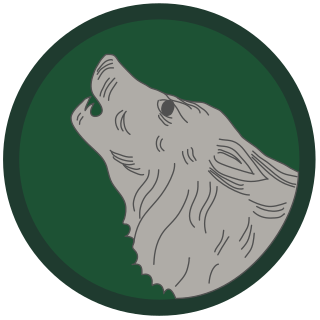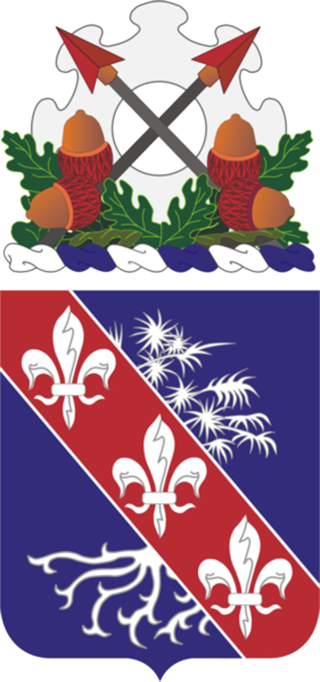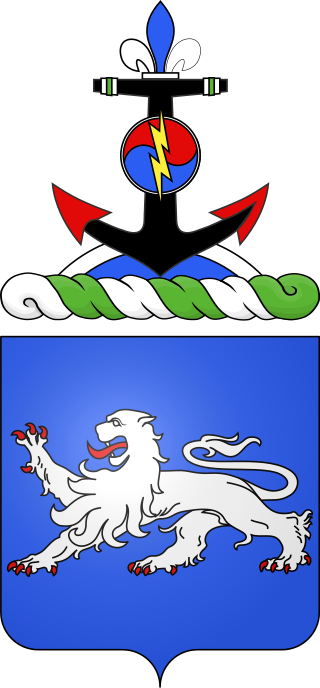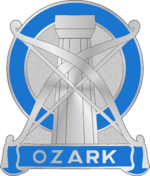
The 104th Infantry Division was an infantry division of the United States Army. Today, it is known as the 104th Training Division (Leader Training) and based at Fort Lewis, Washington, as a training unit of the United States Army Reserve.

The 35th Infantry Division, formerly known as the 35th Division, is an infantry formation of the United States Army National Guard headquartered at Fort Leavenworth, Kansas.

The 84th Training Command ("Railsplitters") is a formation of the United States Army. During World War I it was designated the 84th Division, American Expeditionary Forces; during World War II it was known as the 84th Infantry Division. From 1946 to 1952, the division was a part of the United States Army Reserve as the 84th Airborne Division. In 1959, the division was reorganized and redesignated once more as the 84th Division. The division was headquartered in Milwaukee in command of over 4,100 soldiers divided into eight brigades—including an ROTC brigade—spread throughout seven states.

The 95th Infantry Division was an infantry division of the United States Army. Today it exists as the 95th Training Division, a component of the United States Army Reserve headquartered at Fort Sill, Oklahoma.

The 80th Training Command is a formation of the United States Army Reserve.

The 100th Training Division (Leader Development) (formerly the 100th Infantry Division) is a division of the United States Army headquartered at Fort Knox, Kentucky. It currently serves as a major training command of the United States Army Reserve. It has been known as the "Century Division" owing to its "100th" designation.

The 94th Division was a unit of the United States Army in World War I, and of the Organized Reserve Corps in 1921 until 1942.

The 43rd Infantry Division was a formation of the United States Army from 1920 to 1963, serving in the Pacific during World War II. It was activated in 1920 as a National Guard Division in Connecticut, Maine, Rhode Island, and Vermont. The 143rd Regional Support Group of the Connecticut National Guard now carries on the heritage.

The 27th Infantry Division was a unit of the Army National Guard in World War I and World War II. The division traces its history from the New York Division, formed originally in 1908. The 6th Division designation was changed to the 27th Division in July 1917.

The United States Army Reserve (USAR) is a reserve force of the United States Army. Together, the Army Reserve and the Army National Guard constitute the Army element of the reserve components of the United States Armed Forces.

The 327th Infantry Regiment is an infantry regiment of the 101st Airborne Division of the United States Army. During World War II, the 327th was a glider-borne regiment of the 101st Airborne Division. It fought during World War I as part of the 82nd Division. It has also been deployed in the Vietnam War, Gulf War, and most recently to Iraq and Afghanistan. The song "Glider Rider" describes (humorously) some of the slights that glider-borne troops felt they received from the Army during World War II; though the regiment's public fame rose with the 1949 movie Battleground about the Siege of Bastogne in late 1944.

The 14th Infantry Regiment is a United States Army light infantry regiment. It has served in the American Civil War, Boxer Rebellion, World War II, Korean War, Vietnam War, Operation Restore Hope, Operation Uphold Democracy, Operation Joint Guard, Operation Desert Storm, Operation Enduring Freedom, Operation Gothic Serpent, Operation New Dawn, Operation Resolute Support, and Operation Iraqi Freedom. The 14th Infantry Regiment did not take part in combat during World War I. It has also conducted peacekeeping and humanitarian missions in the Sinai Peninsula, Guantánamo Bay in Cuba, Bosnia, and Kosovo.
The 102nd Field Artillery Regiment is an inactive Field Artillery Regiment in the Massachusetts Army National Guard. Originally organized in 1786, the 102nd Field Artillery's predecessor units served in the Civil War, the Spanish–American War, and World War I. Units of the regiment served with the 26th Infantry Division during World War II and the Cold War.

The 189th Infantry Brigade is an Infantry brigade of the United States Army based at Joint Base Lewis-McChord, Washington. It is a training brigade subordinate to First Army.

The 68th Armor Regiment is an armored regiment of the United States Army. It was first activated in 1933 in the Regular Army as the 68th Infantry Regiment.

The 27th Infantry Brigade Combat Team ("Empire") is an infantry brigade combat team of the New York Army National Guard, one of the brigades that make up the 42nd Infantry Division.

The 26th Infantry Division was an infantry division of the United States Army. A major formation of the Massachusetts Army National Guard, it was based in Boston, Massachusetts for most of its history. Today, the division's heritage is carried on by the 26th Maneuver Enhancement Brigade.

The 108th Training Command (Initial Entry Training) is a United States Army Reserve unit headquartered in Charlotte, North Carolina. At its activation, the unit was designated as the 108th Airborne Division, but in 1952 was redesignated the 108th Infantry Division. In 1956, the division was again reorganized, this time to the designation as the 108th Division (Institutional Training). Under the U.S. Army Reserve Transformation of 2005, the 108th was reorganized to is current structure as the 108th Training Command (Initial Entry Training (IET)). The command is currently one of the largest in the Army Reserve, commanding and coordinating 9,000 soldiers.

The 102nd Cavalry Regiment is a regiment of the United States Army first established in 1913 and which saw service in World War II.

The 1st Battalion, 108th Field Artillery Regiment, 56th Stryker Brigade Combat Team, is the only direct support field artillery battalion in the only National Guard Stryker Brigade in the United States Army.





















